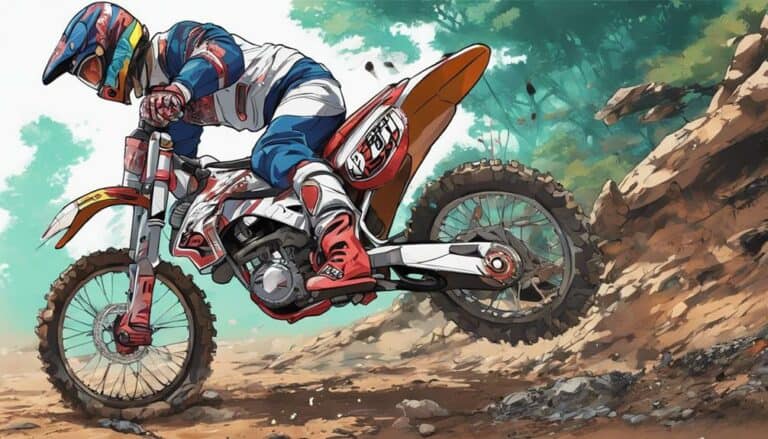When selecting a dirt bike rear spring rate, a staggering 70% of riders are using incorrect settings. Understanding how to choose the right spring rate can greatly impact your bike's performance and your overall riding experience.
By following a few key steps and considering various factors, you can make sure that your dirt bike is properly equipped to handle the terrain you ride on. Mastering the art of selecting the ideal rear spring rate is essential for achieving the best suspension and control.
Key Takeaways
- Rider weight and terrain influence rear spring rate selection.
- Adjust spring rate for performance enhancement and comfort.
- Measure race sag for optimal spring rate calculation.
- Proper spring rate enhances handling, control, and overall riding experience.
Understanding Dirt Bike Rear Spring Rate
Understanding the dirt bike rear spring rate involves analyzing how suspension response and handling are impacted. The rear spring, part of the rear shock system, plays a pivotal role in determining the bike's behavior over varying terrain. The spring rate refers to the amount of force needed to compress the shock springs by a certain distance. Stiffer springs result in a higher spring rate, which can be beneficial for riders who are heavier or more aggressive.
One important concept related to the rear spring rate is sag. Race sag, a term frequently used in dirt biking, is the amount the rear suspension compresses under the weight of the rider. Adjusting the rear spring rate affects the sag, which in turn influences the bike's handling and performance. Riders must find a balance where the rear spring rate provides enough support to prevent bottoming out while allowing sufficient travel for absorbing bumps and maintaining traction. Properly setting the rear spring rate can lead to improved comfort, control, and overall riding experience on the dirt bike.
Factors Affecting Spring Rate Selection
Analyzing various factors is essential for determining the appropriate rear spring rate for your dirt bike. When selecting the rear spring rate, consider the following key factors:
- Rider Weight: The weight of the rider has a significant impact on the performance of the rear spring.
- Terrain: Different terrains require specific rear spring rates for ideal handling and comfort.
- Riding Style: Your riding style, whether aggressive or casual, influences the ideal rear spring rate to match your preferences.
- Suspension Linkage: The design of the suspension linkage and shock setup affect how the rear spring rate interacts with the overall suspension system.
Calculating Optimal Rear Spring Rate
To calculate the best rear spring rate for your dirt bike, begin by measuring the race sag to determine the suitable spring rate based on your weight and riding style. The shock spring plays an important role in supporting the weight of the bike and rider, influencing the overall performance and handling characteristics.
By considering factors such as the weight of the bike and rider, as well as the type of terrain you ride on, you can estimate the required stiffness of the rear spring. Spring rates are typically measured in pounds per inch and vary depending on the manufacturer and specific model of the bike.
A stiffer spring may be necessary for heavier riders or aggressive riding styles, while a softer spring may be more suitable for lighter riders or casual riding. Ensuring the right spring rate will optimize the static sag, maintaining the proper balance and responsiveness of the rear wheel to enhance your overall riding experience.
Adjusting Rear Spring Rate for Performance
How can adjusting the rear spring rate impact the performance of your dirt bike on different terrains?
When you fine-tune your rear spring rate, you can greatly enhance your bike's handling and performance in various racing conditions. Here's how adjusting the rear spring rate can improve your dirt bike's performance:
- Improved Shock Absorption: Adjusting the spring rate allows for better shock absorption, reducing the impact of bumps and jumps during races.
- Enhanced Racing Dynamics: A stiffer spring provides more responsiveness and stability, important for aggressive racing maneuvers.
- Optimized Spring Preload: Fine-tuning the spring preload ensures that the suspension is set up to match your riding style and the terrain you're racing on.
- Balanced Sag Measurements: Setting the sag correctly with a softer spring allows for better weight distribution, improving traction and control during races.
Fine-Tuning Rear Spring Rate for Comfort
Adjusting the rear spring rate to optimize comfort on your dirt bike involves fine-tuning the suspension to match your weight and preferred riding style.
To fine-tune for comfort, consider the 'free sag' and 'race sag' measurements. Free sag is the bike's sag with no rider on it, while race sag is with the rider aboard. Ideally, the race sag should be around 30-35% of the total suspension travel.
If your bike sits too low on the rear axle, indicating a soft spring, you may need a stiffer spring to prevent bottoming out and enhance comfort. To adjust the sag, lift the rear wheel of the bike off the ground and measure from a specific point on the rear axle to a fixed point on the rear fender.
Consulting with a suspension expert like Race Tech or using online calculators can also help determine the most suitable rear spring rate for your comfort needs.
Conclusion
To conclude, selecting the right rear spring rate for your dirt bike is essential for peak performance and rider comfort. Remember, the static sag should ideally be between 30mm and 40mm to guarantee proper handling and suspension response.
Did you know that according to suspension experts, a 10% increase in rear spring rate can result in a noticeable improvement in overall bike performance? Make informed decisions based on measured values for a smoother and more enjoyable riding experience.

